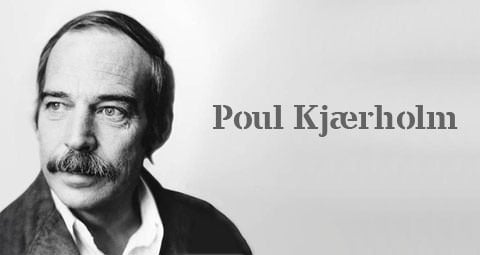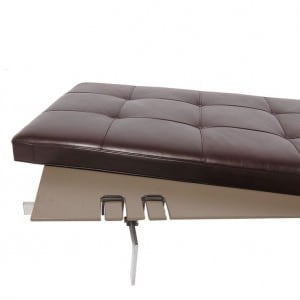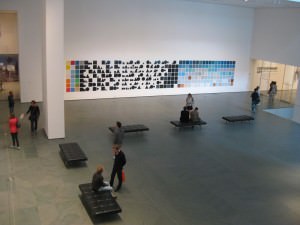Poul Kjaerholm - Cabinetmaker to Modernist Icon - Part Five
Before we carry on into 1957, I would just like to take a side-step to show, for those not aware, the reasoning behind Kjaerholm’s use of numbers to name each of his designs. The truth is, is that there is no real complex system to the formatting; it was just a way of categorising the products by type whilst also revealing, yet again, a continued attempt to pare down his furniture to the bare element and function: chair, table, stool etc. Initially, when working with Kold Christensen, each design was just referred to by numbers but following Kjærholm’s death, once production had been taken over by Fritz Hansen, the numbered designs were prefaced by his initials. The table below should help to explain:
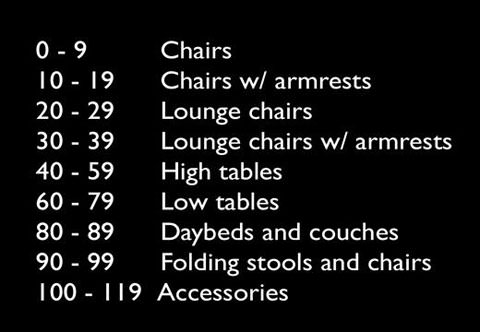
And so, back to 1957 and the birth that year of another future icon from Kjærholm’s stable – the PK 80 Daybed.
Yet again, Mies van Der Rohe provided him with the inspiration but just like before, whilst the Barcelona Daybed was clearly a blueprint in his thoughts when developing his couch, he then went on to simplify and refine that initial idea to produce a piece of furniture that quietly commands attention in any space you choose to use it in.
[caption id="attachment_1809" style="text-align: center;" width="480"]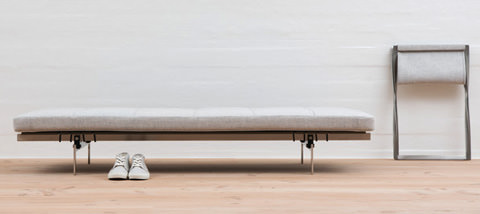 PK 80 Daybed with PK 91 Stool[/caption]
PK 80 Daybed with PK 91 Stool[/caption]
The PK 80 also revealed another, key structural connector that would go on to signify a Kjærholm design - the rubber 'O-ring'. But, whereas the Allen bolt provided a visible, fixed connection to show the elemental nature of his designs, the O-ring allowed Kjærholm to firmly connect the three layers of components (steel, plywood, leather seat pad) contained in the PK 80 whilst also providing the opportunity to easily disassemble the component parts without the use of any tools.
This layering of independent components connected by O-rings was also apparent in his PK 33 Stool design which appeared a year later in 1958. Along with the Allen bolt, the O-ring brought Kjærholm nearer and nearer to the brink of his mission in finding and revealing a "pure construction" within his work.
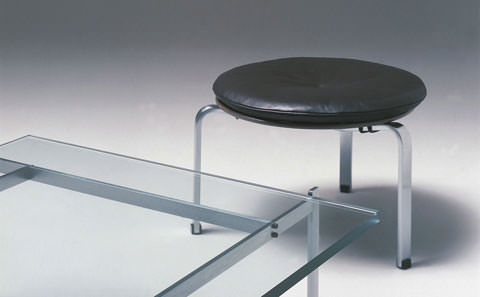
PK 33 Stool
If we momentarily jump forward to 2004, I can share a story involving the PK 80 which shows the enduring nature of Kjærholm's designs sprinkled with a little mysticism. The Museum of Modern Art in New York approached Fritz Hansen in that year with regards to installing the daybed for visitors to use in their galleries. But, they made a special request and asked for the height of the seat to be extended in order to bring it in line with the height at which the majority of their canvases were hung, thus providing a more comfortable viewing platform for their visitors.
Fritz Hansen were of course delighted that such a prestigious institution wished to house a piece of furniture they produced and duly approached the family of Kjærholm to check the scope in honouring MOMA's request. Hanne Kjærholm, Poul's widow, held control of her late husband’s legacy of designs at that time and before accepting Fritz Hansen's proposal on behalf of MOMA, they were informed that she would “need to discuss this matter with Poul”. Obviously, the powers that be at Fritz Hansen were a little thrown by this response but had no choice but to abide and wait for a decision. When the official response materialised, it was positive and they were given the go-ahead but, according to Hanne, Poul had told her that if they wished to change the seat height of the Daybed, they would also need to adjust the thickness of the seat cushion so it wouldn’t lose its original balance in proportions.
But, fear not, Kjærholm was not actually making design decisions and alterations from the afterlife. A reliable source at Fritz Hansen tells me that after speaking to Thomas Kjærholm (his son), it appears that this piece of whimsy on Hanne’s part was made up and just a light-hearted way of saying that the philosophy behind her husband’s work should be respected. Hanne Kjærholm passed away in 2009 and the rights to the Kjærholm collection were passed on to her children, Thomas and Krestine, who still uphold a firm protection over their father’s collection against any changes or tweaks Fritz Hansen may wish to discuss.
To be continued...